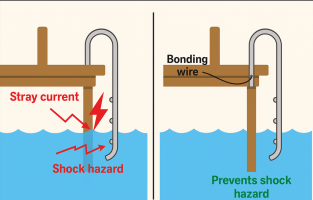jar546
CBO
I received this email sent to a bunch of us from one of our peers:
Good Evening Colleagues,
I’m reaching out to gather your perspectives on how your organizations handle metal ladders installed on docks that have any source of electrical power (shore power pedestals, boat lifts, lighting, receptacles, etc.). There’s been some suggestion that my jurisdiction is alone in enforcing this aspect of the NEC; I’d like to compare practices, code interpretations, and rationale across jurisdictions and trades.

This is the other side of the argument.
Do you require bonding of metal ladders at any dock with electrical service? If not, what is your code basis and safety analysis?
Thank you in advance for weighing in. Our shared goal is to reduce electric-shock risk at docks through clear, consistent application of NEC 555.
Regards,
Good Evening Colleagues,
I’m reaching out to gather your perspectives on how your organizations handle metal ladders installed on docks that have any source of electrical power (shore power pedestals, boat lifts, lighting, receptacles, etc.). There’s been some suggestion that my jurisdiction is alone in enforcing this aspect of the NEC; I’d like to compare practices, code interpretations, and rationale across jurisdictions and trades.
- NFPA 70 (NEC) Article 555.13: “All non–current-carrying metal parts that are likely to become energized shall be connected to the branch circuit or feeder equipment grounding conductor by a bonding conductor that is insulated, covered, or bare and is not required to be larger than 8 AWG copper.”

This is the other side of the argument.
Do you require bonding of metal ladders at any dock with electrical service? If not, what is your code basis and safety analysis?
Thank you in advance for weighing in. Our shared goal is to reduce electric-shock risk at docks through clear, consistent application of NEC 555.
Regards,
